No products in the cart.
NEWS
Discover the World of Unique Plant Varieties for Your Garden
The fascination with sourcing and cultivating unique plant varieties is a growing trend among garden enthusiasts and plant collectors. Many find joy in nurturing these unusual specimens, adding distinctive character to their green spaces or exploring their potential for specialized cultivation. Varieties like the ‘Sung My’ Fig, Red Flesh Sapodilla, Taiwanese Pineapple Custard Apple, and Golden Star Apple are examples of novel introductions that have gained popularity due to their appealing characteristics, ease of growth, high productivity, and numerous benefits. If you are interested in exploring the realm of unique plant varieties, let’s delve into some of the most sought-after types available today.
Exploring Popular Unique Plant Varieties
The desire to cultivate something different, something that stands out, drives many gardeners to seek out unique plant varieties. Beyond novelty, these plants often offer superior traits like enhanced flavor, increased nutritional value, or exceptional ornamental beauty, making them valuable additions to both home gardens and specialized farms.
Fig (‘Sung My’): A Sweet and Prolific Delight
 Ripe 'Sung My' figs on a branch, showing their distinctive pear shape and purplish skin.
Ripe 'Sung My' figs on a branch, showing their distinctive pear shape and purplish skin.
The ‘Sung My’ Fig is a notable unique plant variety originating from the United States, highly prized for its sweet, subtly fragrant, and flavorful fruit. This fruit tree is not only rich in nutrients but also offers the appealing characteristic of fruiting year-round, with harvests possible just months after planting. ‘Sung My’ Figs can thrive planted directly in the ground or in pots, serving a dual purpose as both a productive fruit source and an attractive ornamental plant.
Characteristics of the ‘Sung My’ Fig Tree
Also known as the Sweet Fig, this variety originally comes from Western Asia but is most widely cultivated in the southern United States. ‘Sung My’ Figs are typically bushy plants. When grown in certain climates, they can reach heights of 1.5 to 2 meters, though they are reported to grow much taller (up to 6m) and live for up to 200 years in ideal conditions like those in the US. Key characteristics include:
- Leaves: The leaves are large, broad, and somewhat fuzzy, measuring about 10-20 cm. They are distinctly lobed, usually with 3 to 5 prominent lobes, resembling papaya leaves. Unlike some other fig varieties, ‘Sung My’ leaves are not typically consumed fresh.
- Fruiting Habit: This tree is known for its year-round fruiting and high yield potential. It is reported that a single branch can produce 200-300 fruits per season, contributing to a high overall yield for the tree.
- Growth to Fruiting: ‘Sung My’ Fig trees can start producing fruit within just 6 months of planting, and the time from flowering to ripe fruit is relatively short, often just about a month.
- Flowers: The flowers are small, and most on the tree are female.
- Fruit: The fruit develops singly from the leaf axils, unlike the clustered fruit of some traditional fig varieties. ‘Sung My’ figs are considerably larger than common figs, pear-shaped or somewhat elongated-spherical, measuring about 2.5 to 10 cm. When ripe, the skin color ranges from deep yellow to dark purple. The skin is thin and soft, and the flesh is white or pale yellow, containing a lot of juice. The taste is sweet and notably crisp compared to some common fig types, making them highly desirable.
Nutritional Value of ‘Sung My’ Figs
Research indicates that ‘Sung My’ figs possess high nutritional content and may offer various health benefits:
- Rich in Vitamins, providing nutritional supplementation, boosting health, and acting as a natural laxative.
- Contain Vitamins A and B, along with numerous minerals, promoting appetite, supporting eye health, and stimulating energy regeneration.
- High in Potassium and low in Sodium, which can help manage high blood pressure.
- High Calcium content contributes to strong bones and effective digestive support.
- Reportedly contain 15% more Zinc than traditional figs, potentially beneficial for male reproductive health.
- Some studies suggest ‘Sung My’ figs can help eliminate harmful gut bacteria while stimulating the growth of beneficial ones.
- They are a good source of easily absorbed Calcium, offering an alternative calcium source for those who cannot consume milk.
Beyond being an attractive and fruitful plant, the ‘Sung My’ Fig also carries positive symbolic meaning in some cultures, making it suitable for planting in gardens, pots, or even as a bonsai.
Red Flesh Sapodilla: Exotic Beauty from Thailand
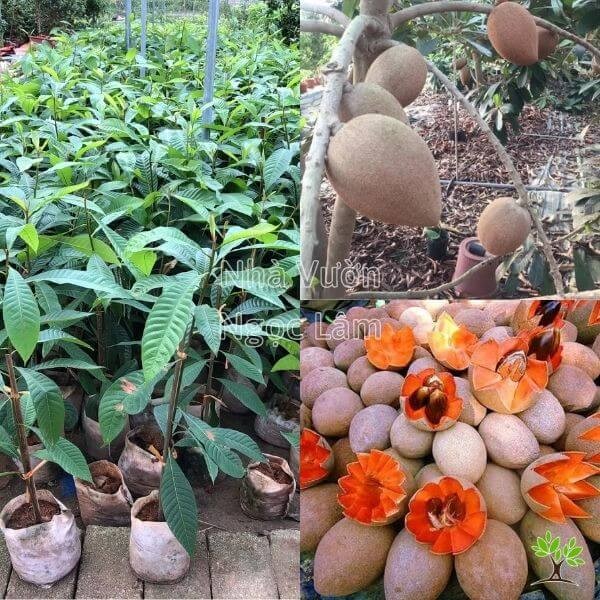 Cross-section of a Red Flesh Sapodilla revealing its vibrant red flesh and small seeds.
Cross-section of a Red Flesh Sapodilla revealing its vibrant red flesh and small seeds.
The Red Flesh Sapodilla is a unique plant variety that has become quite familiar to many. Its appeal lies in the distinctive light brown skin and the deliciously fragrant, sweet fruit, making it a favorite for consumption.
Characteristics of the Red Flesh Sapodilla Tree
Originating from Thailand, the Red Flesh Sapodilla is well-suited to many tropical and subtropical climates. It is known for its hardiness and high yield potential, leading many growers to prefer and adopt this variety over older sapodilla types.
- Climate & Soil: As a tropical fruit tree, it thrives best in temperatures between 23-34°C. It is adaptable to various soil types but prefers light, well-drained loamy soil with a pH of 4.5-6.5.
- Tree Structure: It is a long-lived tree. Mature trees can reach heights of 3-4 meters with a canopy spread of approximately 4 meters.
- Fruiting: Trees typically start bearing fruit from the 3rd year after planting. A mature tree can yield 15-20 fruits per season.
- Fruit Size & Shape: Individual fruits are large, averaging 700-800g, with some specimens reaching up to 2 kg. The fruit is elongated, measuring 17-20 cm in length.
- Appearance: The skin is light brown with many small, rough thorns (actually bumpy surface). The flesh, however, is a striking, unusual red color.
- Taste & Texture: The fruit is soft, sweet, and fragrant, with a pleasant taste that isn’t overly rich. When served chilled, the sweetness and flavor are enhanced.
Nutritional Value of Red Flesh Sapodilla
Beyond its visual appeal and delicious taste, the Red Flesh Sapodilla is recognized by scientists for its rich nutritional content beneficial for health.
- Vitamin A: Contains 1.5-2 times more Vitamin A than common sapodilla varieties.
- Minerals & Fiber: Higher levels of minerals like Iron and Magnesium, as well as fiber and sugar, compared to common sapodillas. This contributes to energy provision, nutrient supply, increased physical strength, and improved immunity.
- Antioxidants: Contains compounds that support overall health and may help protect against certain diseases by boosting the body’s defense systems.
The Red Flesh Sapodilla is valued not just for its beautiful fruit and delicious flavor but also for its significant nutritional benefits.
Taiwanese Pineapple Custard Apple: The “King” of Custard Apples
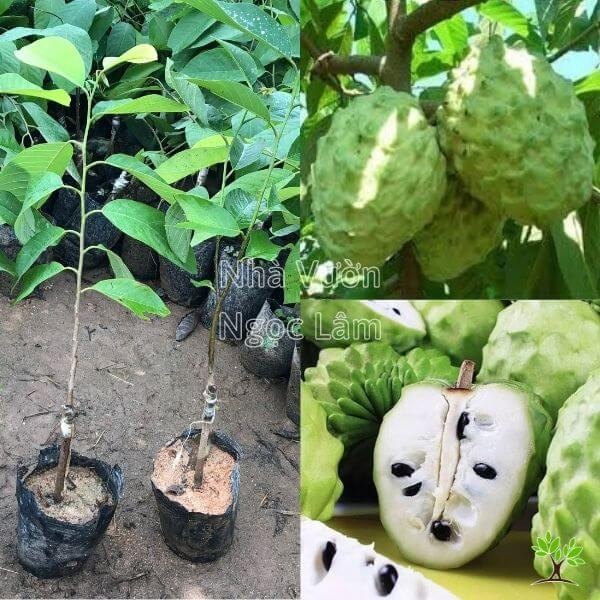 Large Taiwanese Pineapple Custard Apple fruit hanging from a branch, showing its segmented skin.
Large Taiwanese Pineapple Custard Apple fruit hanging from a branch, showing its segmented skin.
The Taiwanese Pineapple Custard Apple, also known simply as Taiwanese Custard Apple, is celebrated as the “King” of custard apples. It is highly sought after among unique plant varieties for its pleasant sweetness, refreshing taste, and rich content of vitamins and minerals beneficial for the body. This variety boasts numerous outstanding characteristics that make its seedlings very popular.
Characteristics of the Taiwanese Pineapple Custard Apple Tree
This variety is considered one of the finest custard apples. Its fruits are large, with significant weight, thick flesh, and a taste superior to many custard apple varieties grown elsewhere.
- Growth Rate: The tree grows very quickly, reaching about 2m in height after just over a year and beginning to flower. It develops well, with large leaves, long shoots, and few branches.
- Fruiting: It starts producing fruit after only 2 years of planting, yielding two crops per year.
- Flavor & Texture: The taste is a unique blend of sweet custard apple with notes of pineapple. The fruit has a deep sweetness and maintains an attractive green or slightly yellow skin color when ripe. The segments are large, the flesh is firm, smooth, and has small, few seeds.
- Fruit Size: Fruits are large, typically weighing 700-800g, and sometimes reaching 1 kg.
- Adaptability: This variety is highly compatible with the climate and soil conditions in many tropical regions. When grown in suitable areas, it thrives, developing a canopy 1.5-2 times larger than common custard apple varieties, making it popular among growers.
Nutritional Value of Taiwanese Pineapple Custard Apple
Taiwanese Pineapple Custard Apple has a distinct, delicious flavor, sweet flesh, and is packed with Vitamin C, Potassium, fiber, various vitamins, minerals, and Carbohydrates.
Nutritional information highlights the abundance of beneficial compounds: up to 72% Glucose, 14.52% Saccharose, 1.73% starch, and 2.7% Protein. 100g of flesh provides about 64 Kcal, 36mg Vitamin C, 82.5g water, 1.6g Protein, 35mg Calcium, 0.8g Cellulose, 1.6g Glucid, and 45mg Phosphorus. It also contains B vitamins and trace elements like magnesium and zinc.
Benefits of consuming Taiwanese Pineapple Custard Apple include:
- Eye Health & Skin Beauty: Rich in Riboflavin and Vitamin C, supporting eye health and promoting beautiful skin.
- Respiratory Support: Vitamin B6 may help reduce symptoms of respiratory issues and cough.
- Heart Health: High Magnesium content is considered beneficial for people with heart conditions and may help prevent heart pain.
- Digestive Health: Fiber aids the digestive system, reducing constipation and lowering the risk of type 2 diabetes.
- Cholesterol Management: Fiber and Niacin help reduce blood cholesterol levels.
- Anemia Support: High Iron content is beneficial for individuals with anemia.
- Blood Pressure Regulation: Potassium and Magnesium help regulate and stabilize blood pressure.
- Potential Anti-cancer Properties: Acetogenin compounds are being studied for their potential in treating pre-cancerous skin lesions and potentially preventing skin and other cancers.
- Joint Health: High Magnesium helps balance body water, aids in removing excess acid from joints, and may reduce the risk of arthritis.
With its delicious taste and impressive benefits, the Taiwanese Pineapple Custard Apple is highly sought after for cultivation and propagation.
Golden Star Apple: A Radiant Tropical Fruit
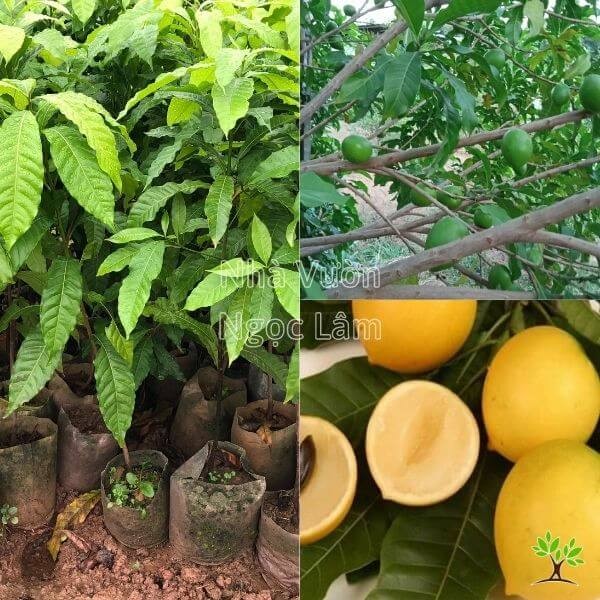 Bright yellow Golden Star Apple fruits growing directly on the trunk and branches of the tree.
Bright yellow Golden Star Apple fruits growing directly on the trunk and branches of the tree.
The Golden Star Apple, also known as Taiwanese Star Apple or Abiu, is a unique plant variety producing delicious, high-quality fruit that is increasingly in demand.
Characteristics of the Golden Star Apple Tree
- Growth & Fruiting: It is a woody tree that begins to fruit relatively quickly, typically after just 2 years of planting.
- Structure: Trees reach a height of 2-4 meters with a wide canopy. The leaves are large, resembling those of the Sapodilla.
- Unique Fruiting Habit: A distinctive feature is that the fruits grow directly on the branches or trunk of the tree, a contrast to typical star apple varieties.
- Fruit Appearance: The fruit has taut, glossy skin, which is green when young and turns a vibrant yellow when ripe. Unlike common star apples, which are perfectly round, the Golden Star Apple fruit often has a small, pointed tip at the bottom. It contains a single seed located in the center, which is very small, about the size of a fingertip. The skin is thin, and the flesh is thick, clear, and soft.
- Fruit Size: Golden Star Apple fruits are large, weighing between 300-350g each.
- Adaptability: This variety is well-suited for cultivation in many tropical regions, being easy to grow and providing year-round harvests.
Nutritional Value of Golden Star Apple
The Golden Star Apple is popular not only for its attractive appearance but also for the significant nutritional value it offers.
Key nutritional benefits include:
- Rich in Vitamin C and Antioxidants: Research indicates that 100g of Golden Star Apple can provide approximately 34.7mg (equivalent to 57% of the daily recommended amount) of Vitamin C. Regular consumption helps boost the immune system and protects the body from harmful agents.
- Abundant Minerals: High in Calcium, which contributes to strong bones and teeth and may help reduce symptoms associated with premenstrual syndrome.
- High in Fiber and Water: These nutrients protect the mucous membrane of the large intestine and may help prevent the development of colon cancer-causing substances. They also contribute to a feeling of fullness, supporting effective and healthy weight loss. Regular consumption helps lower blood glucose levels and may prevent diabetes.
- Low in Calories and Harmful Substances: Golden Star Apple is low in calories and lacks harmful sugars or fats, making it an excellent choice for those on a diet.
Wisteria: Cascading Beauty from Asia
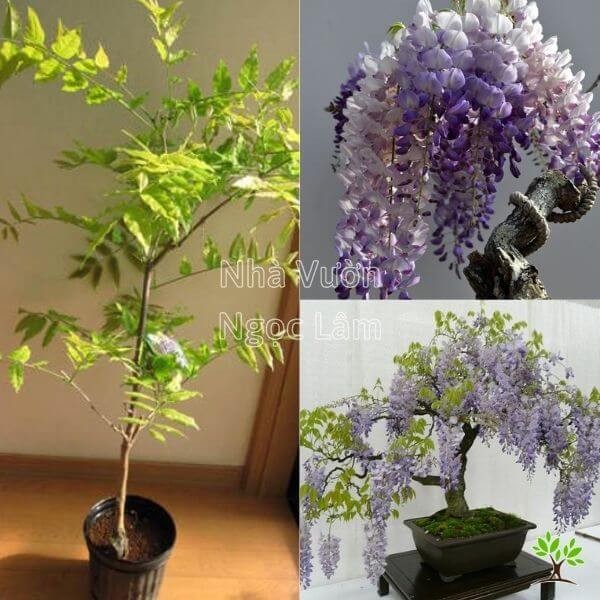 Beautiful purple Wisteria flower clusters hanging from a trellis.
Beautiful purple Wisteria flower clusters hanging from a trellis.
Wisteria is a beautiful flowering plant, relatively new to many regions outside of its native Asia. It is a climbing plant known for its spectacular cascading flower clusters, providing excellent shade. Many gardeners cultivate Wisteria to create stunning floral displays.
Characteristics of the Wisteria Vine
- Growth Habit: Wisteria is a woody vine that can climb to heights of up to 20 meters and spread horizontally up to 10 meters.
- Leaves: Leaves grow opposite each other and are 15-35 cm long. They are pinnately compound, with 9-19 leaflets. Wisteria is deciduous, losing its leaves in winter, after which it typically flowers.
- Flowers: Flowers appear in clusters that hang from branches, drooping down 10-80 cm. They come in shades of purple, pink, or white and are fragrant, particularly certain imported varieties.
- Root System & Longevity: The plant has a deep taproot with shallow, widely spreading lateral roots. It grows quickly and is long-lived, potentially surviving for hundreds of years. Its vines are strong and climb effectively.
In regions with distinct seasons, like Northern Vietnam with its short winter, Wisteria often blooms around February or March in the lunar calendar (near the traditional Lunar New Year). A notable characteristic is that older, more mature trees produce more abundant blooms. Patience is key to cultivating a truly magnificent Wisteria vine.
Meaning of Wisteria
Wisteria is found globally, and its symbolism varies across cultures:
- In Western countries: Wisteria often signifies good things in life, representing love, admiration, and cherishing loved ones.
- In Japan: It is a symbol of eternal, immortal love. It also signifies cherishing, affection, and letting go of grudges.
- In China: Wisteria represents sacred, sincere, and noble friendship.
Furthermore, the meaning can vary based on the flower color:
- Purple Wisteria: Symbolizes eternal, immortal love, unity, harmony, affection, and releasing resentment.
- Yellow Wisteria: Represents strong friendship, youthful vibrancy, and dynamism.
- White Wisteria: Signifies good luck and lasting happiness, often used in wedding decorations.
- Green Wisteria: Carries the meaning of brightness, life, and growth, frequently used for opening ceremonies.
- Pink Wisteria: Represents budding love and the innocence and playfulness often associated with young girls.
Seven-Segment Peach (‘Đào Thất Thốn’): The “Empress” of Peaches
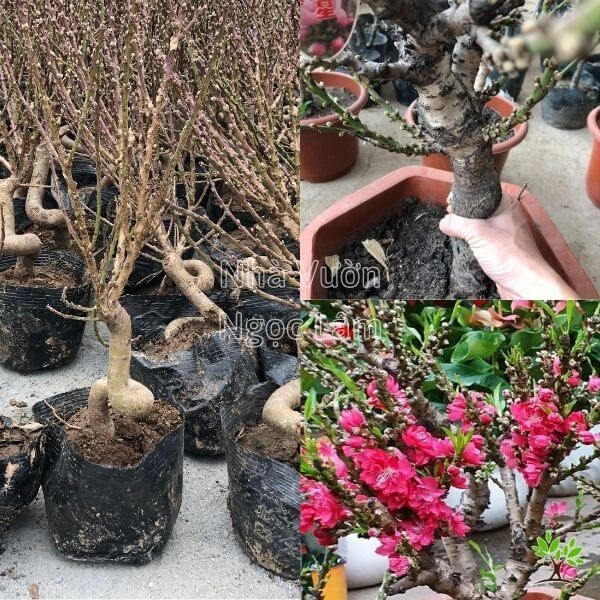 Close-up of deep pink, multi-petaled 'Đào Thất Thốn' peach blossoms on a gnarled branch.
Close-up of deep pink, multi-petaled 'Đào Thất Thốn' peach blossoms on a gnarled branch.
The ‘Đào Thất Thốn’ Peach is often hailed as the “Empress” among peach varieties, celebrated for its subtle beauty and unique, refined characteristics not found in other peaches.
Characteristics of the Seven-Segment Peach Tree
This is an ancient, rare ornamental peach variety known for its remarkable vitality.
- Structure: The tree has a short, stocky form. Leaves are large, long, and dark green. The trunk and branches are gnarled and bumpy from base to tip, giving it an ancient, weathered, and distinctive appearance. It grows very slowly, only adding a few centimeters per year.
- Wood and Bark: The inner wood from the root up to the tip is red. The buds are sharp and strong. When the bark is peeled, it reveals a plum color rather than the typical wood color of other peaches.
- Flowering: Unlike most peaches that bloom for Tet (Lunar New Year), ‘Đào Thất Thốn’ typically blooms around the 15th of the first lunar month. The flowers are large with thick petals. They are a deep pink tending towards red, making them very vibrant. The yellow pistils stand up elegantly. Uniquely, this peach can sometimes produce flowers directly from dry nodes on the trunk. It starts flowering from the 3rd year of planting, and after 7 years, it produces double flowers, each layer having 7 petals. At night, the flowers emit a faint fragrance. Each flower has about 49 densely packed petals, while common peaches usually have a maximum of 20. After wilting, the flowers clump together rather than falling like common peach blossoms.
- Leaves: The leaves are 3-4 times longer than those of common peaches, about 23-25 cm, covering the nodes along the branches. When pruning or stimulating bud growth, growers must be extremely skillful to avoid damaging the tree.
- Cultivation: ‘Đào Thất Thốn’ can only be grown in loamy soil that has been dried to reduce acidity. It requires watering with clean water. Cultivating a beautiful ‘Đào Thất Thốn’ tree requires significant knowledge and persistence.
Due to its unique characteristics and demanding cultivation, the ‘Đào Thất Thốn’ peach holds a strong appeal for discerning flower enthusiasts.
Meaning of the Seven-Segment Peach
The name “Đào Thất Thốn” (Seven Segments Peach) is attributed by experienced growers to several characteristics: the tree is said to bloom when it reaches 7 tấc (a traditional unit, roughly 1m) above the ground; it starts flowering after 3 years and produces double flowers after 7 years, with each layer having 7 petals; and branches are said to divide every 7 thốn (7 nodes).
Like other peach varieties displayed during Tet, ‘Đào Thất Thốn’ carries special symbolic meanings:
- Symbol of Fertility and Growth: With its tenacious vitality, ‘Đào Thất Thốn’ strives to bloom vibrantly amidst the harsh cold rain of early spring. This symbolizes longevity, strong vitality, and fertility. It also represents the unity of family members.
- Ward off Evil: Displaying a peach branch during Tet is believed to dispel misfortune from the old year and welcome good things in the new year.
- Symbol of Luck and Happiness: The deep red color of the peach blossoms during Tet is seen as an omen of impending luck, prosperity, and happiness.
Ruby Guava: A Seedless Gem
 A sliced Ruby Guava showing its vibrant pink-red flesh and minimal seeds next to a whole fruit.
A sliced Ruby Guava showing its vibrant pink-red flesh and minimal seeds next to a whole fruit.
In recent years, the Taiwanese Ruby Guava variety has become increasingly popular due to its unique and outstanding characteristics.
Characteristics of the Ruby Guava Tree
- Appearance: Ruby Guava looks similar to other common guava varieties from the outside. The fruit is round with bright green, slightly bumpy skin.
- Skin & Flesh: Unlike other guavas, Ruby Guava has a firm, crisp skin, making it excellent for long-distance transport. The flesh is striking red-pink with very few seeds; many fruits are completely seedless.
- Flavor: The taste is a delightful combination of the light sweetness and gentle fragrance from the skin with the rich sweetness of the red-pink flesh, creating a unique and appealing flavor that is widely loved.
- Size & Yield: Each fruit weighs approximately 300-450g. The fruit set rate for this variety is high, around 80%.
- Fruiting in Suitable Climates: When grown in favorable climates, Ruby Guava fruits year-round, with two particularly abundant seasons per year. This makes the variety highly economical and suitable for commercial cultivation or as an ornamental plant.
Nutritional Value of Ruby Guava
Ruby Guava is packed with vitamins and minerals that are very beneficial for the body. Some notable benefits include:
- Maintains Healthy Skin: Contains powerful antioxidants that neutralize free radicals, which are harmful factors to human health. Regular consumption helps reduce sagging, wrinkles, dullness, and dryness. The high Vitamin C content stimulates collagen and elastin production, improving skin texture, protecting the skin from environmental damage, and helping to prevent acne.
- Improves Thyroid Function: Contains trace elements that are beneficial for thyroid function, helping to regulate hormones and contribute to a healthier body.
- Stimulates Cognitive Function: Regular consumption stimulates brain activity, nourishes the mind, and supports healthy brain function. Vitamin B3 aids blood flow to the brain, while high Potassium content supports brain function and helps increase positive thoughts and improve memory.
- Good for Eye Health: Vitamin A in Ruby Guava helps improve and maintain vision. Regular eating can improve vision in the short term and slow down macular degeneration and cataract formation.
- Prevents Cancer and Boosts Immunity: A significant benefit is its role in boosting immunity and potentially preventing cancer. Minerals like Vitamin C, Quercetin, and Lycopene are reported to have anti-tumor and anti-cancer effects. They also act as powerful antioxidants, neutralizing harmful free radicals that can lead to cancer.
With its delicious taste and wonderful health benefits, Ruby Guava is highly sought after for planting and propagation today.
Red Dacca Banana: An Australian Ruby
 A bunch of unripe Red Dacca Bananas showing their distinctive deep red skin.
A bunch of unripe Red Dacca Bananas showing their distinctive deep red skin.
The Red Dacca Banana is a unique plant variety originating from Australia, characterized by its smaller fruit and thick skin that is distinctly red. Although the skin is red, the flesh inside turns yellow like common bananas when ripe. However, the flesh is softer and sweeter, and the taste is quite special, often described as having notes reminiscent of raspberries. This unique appearance makes it a particular favorite for ornamental planting among plant collectors.
Characteristics of the Red Dacca Banana Plant
The Red Dacca Banana is a herbaceous plant lacking woody tissue, making it sensitive to strong winds. Its overall form, including the pseudostem and leaves, is similar to other banana varieties, with the main difference being the fruit.
- Fruit Appearance & Size: The fruit is smaller than common bananas, with skin ranging from deep red to slightly purple. The flesh is initially creamy white or pinkish white, turning pale yellow when ripe.
- Flavor: The flavor is distinctive; besides the characteristic banana taste, many detect notes similar to raspberries, making it quite unique.
- Ornamental Value: Its unusual and eye-catching appearance makes it a popular choice for ornamental planting.
Nutritional Value of Red Dacca Bananas
Red Dacca Bananas contain more Beta-carotene and Vitamin C than yellow bananas. Beta-carotene is converted into Vitamin A in the body, benefiting eye health, skin, and the immune system. They are also high in fiber, which can help reduce the risk of Type 2 diabetes. Regular consumption of Red Dacca Bananas is associated with several other health benefits:
- Prevents Kidney Stones: High Potassium content can help prevent kidney stone formation and may reduce the risk of cardiovascular diseases and certain cancers. It also helps maintain calcium balance and improves bone and joint health.
- Aids Weight Loss: Red Dacca Bananas contain fewer calories compared to many other fruits. Eating them can help you feel full longer without consuming excessive calories.
- Reduces Anemia: The abundance of vitamins and antioxidants improves hemoglobin levels and supports the immune system. The Vitamin B6 content can help alleviate anemia.
- Heartburn Relief: Red Dacca Bananas have an antacid effect that significantly reduces heartburn symptoms. Regular consumption is recommended for individuals who frequently experience heartburn.
Durian Custard Apple: A Unique Tropical Hybrid
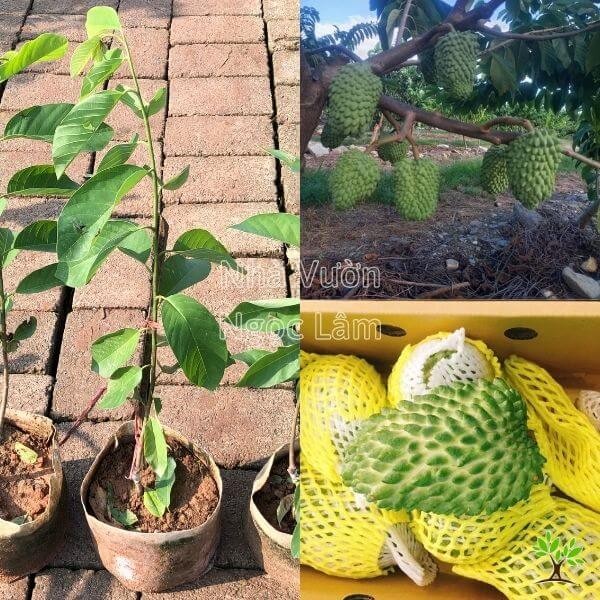 A large, ripe Durian Custard Apple fruit hanging on a tree, showing its oblong, conical shape.
A large, ripe Durian Custard Apple fruit hanging on a tree, showing its oblong, conical shape.
The Durian Custard Apple is a highly popular unique plant variety, favored for its visually impressive large fruits, sweet and fragrant taste, and high economic value.
Characteristics of the Durian Custard Apple Tree
Originating from Taiwan, this variety is well-suited to tropical climates and is widely cultivated in these regions.
- Leaves: Leaves are oval, thin, with a pale green underside, growing around the branches and stem.
- Flowers: Flowers are solitary or grow in clusters of 2-4 at the tips of branches or opposite leaves. They are pale yellow with narrow, thick, tapered petals. The calyx is triangular.
- Fruit: The fruit is not round but has an elongated, conical shape. The skin is thin, and the flesh is white with few seeds. The flesh is firm, sweetly refreshing, and carries a faint, characteristic durian fragrance. The fruits are large, weighing 0.8-1.5 kg, which is 2-3 times heavier than traditional custard apple varieties. When ripe, the taste is similar to the firm, sweet ‘Na Dai’ variety from Taiwan.
Nutritional Value of Durian Custard Apple
Besides its high economic value, the Durian Custard Apple has significant nutritional value and a unique flavor that makes it highly sought after.
Some of the wonderful benefits of Durian Custard Apple include:
- Eye Health and Skin: High in Vitamin C and A, which are very beneficial for eye health and skin.
- Heart Health: Magnesium content is considered good for individuals with cardiovascular conditions.
- Digestive Health: Fiber supports the digestive system, reduces constipation, lowers the risk of type 2 diabetes, and helps reduce blood cholesterol levels.
- Anemia: High Iron content makes Durian Custard Apple beneficial for people with anemia.
- Blood Pressure: Potassium and Magnesium help regulate and stabilize blood pressure.
- Overall Health: Regular consumption may help prevent bone and joint diseases, boost immunity, and potentially inhibit the development of cancer cells.
Finding These Unique Plant Varieties
Today, unique plant varieties are becoming more accessible to many. If you are interested in purchasing unique plant seedlings for cultivation or as ornamental plants, it’s essential to research their characteristics, care requirements, and the benefits they offer. A common question is where to find reliable sources for these unique plants.
When choosing a supplier, consider factors such as a diverse and abundant selection of plants, healthy plant stock, and convenient transportation options. If you are looking for a source for unique plant varieties, you can explore the range offered by Biogarden.asia. Biogarden.asia provides a large selection of plant varieties, from indoor plants to shade trees and production plants, ensuring quality options for your needs.
Conclusion
Exploring unique plant varieties adds an exciting dimension to gardening, offering not just novelty but also potential for delicious fruit, nutritional benefits, and striking visual appeal. From the prolific ‘Sung My’ Fig and the vibrant Red Flesh Sapodilla to the intriguing Taiwanese Pineapple Custard Apple, Golden Star Apple, and Durian Custard Apple, along with the ornamental beauty of Wisteria and Seven-Segment Peach, and the distinct flavor of Red Dacca Banana, there is a world of botanical wonders waiting to be discovered. Cultivating these plants can be a rewarding experience, enriching your garden and providing unique harvests. We encourage you to explore the possibilities and perhaps add some of these unique treasures to your own garden collection. Discover these fascinating plants and more at Biogarden.asia.



